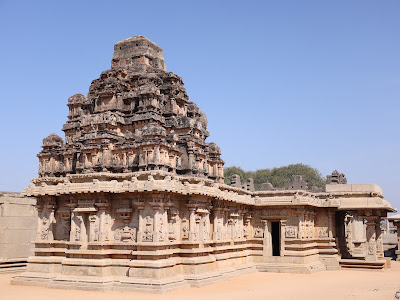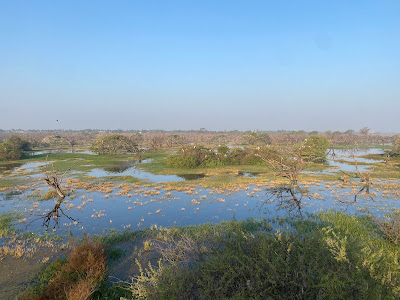After two hours of waiting at the train station, distracted with the monkeys looking for food, the dogs waiting for a bite to start the day, people coming out of their cloth covers after waking up, and adults and children passing from one platform to another, jumping on the train rails, we began our journey to Hampi. Just half an hour before arriving at our destination, we observed a change in the landscape; banana, coconut, and rice plantations predominated around us.
We arrived at our accommodation and, essentially, we sat down to talk under a mango tree. This was a great beginning; Naresh shared his stories about the place and the recent events of his life, while the birds jumped from one tree to another, the dogs dozed at his feet between one caress and the next, and the leaves of the trees whispered with the passage of the wind, with that softness of the subtle.
After a light bite of rice and dal, which was comforting, we went to look for a place to see the sunset. Naresh had announced us an unforgettable place. We arrived at the Shri Achyutaraaya Swamy temple 20 minutes before sunset. The warm light awakened the grey, reddish, and ochre colours of the rocks; the songs of the monks in the temple created a unique and welcoming atmosphere, enough to consider it unforgettable. We passed by the side of the temple and began to ascend the mountain among fragments of barely preserved archaeological remains. We crossed the ground floor of the last ruined temple and ascended to its roof, where the immensity was revealed. A 360-degree view of granite rocks, cultivated valleys, terraces with rice crops and coconut palms, rivers and canals, interrupted only by the archaological remains of a kingdom that left a mark. We never expected this landscape, a unique and picturesque beauty that occupied our entire existence. There, in the silence and stillness, we sit down to enjoy the sunset on the pieces of stone carved and used by a people 17 centuries ago.
Hampi was the capital of the Vijayanagara Empire between the 14th and 16th centuries CE. It covers more than 25 square kilometres of scattered ruins which include temples, palaces, markets, and residences, perfectly articulated with the surrounding environment. It is an example of planned urbanisation of an imperial capital and the recognition of its role as a key city on the Silk Road.
The structures have a unique character; the carved stone and the sound columns characterize these spaces. In its time, the great hall of the Vijaya Vithala temple was a structure formed by 56 sound pillars of granite - lithophones - that, when touched with sandalwood sticks or by hand, produced the music that accompanied the ceremonies and celebrations. Today it is possible to appreciate at least six different forms of music produced with this instrument.
On the other hand, it is necessary to highlight the richness of the stone carving, rich in its detail, in its expressive capacity and in the contents that, in addition to evoking religious elements, exalt those of everyday life, nature, and the commercial practices of the time. The temples have places of worship, but also with spaces for fun, socialisation and commerce, and it is possible to appreciate evidence of all these structures in the different components of the architectural complex.
In the centre of the city, the Virupaksha temple is an active worship centre, with a highly decorated 9-level tower that constitutes its gateway. Its position, at the end of the historical bazaar and in the middle of the active life of Hampi, makes it an unmissable reference point.
This is a dry region; the rains occur in August and are intermittent. Over time, dams and canals have been built to ensure the water supply to its inhabitants, as well as the sustainability of crops. With water and plantations, birds find a safe space, and with birds, we find immense joy. We explored the Ankasamudra bird sanctuary and arrived just when the sun was starting to heat up. The activity was intense: the birdsongs filled all the senses and moved in abundant groups. When we climbed up to the observation tower, the view was breathtaking; the trees and shrubs play their role as places of nesting, courting, and reproduction. The flooded areas receive abundant waterfowl, and on the edges, the birds of the swamps walk between the plants and their prey in that continuous exercise of feeding. Ragú, our guide, helped us observe the diversity of species and then guided us through the route through the savannah birds. His calm presence, along with his sharp and experienced eye, allowed us to enjoy that different world of birds in which we found ourselves.
For the first time on this trip, we were able to enjoy the fire. Our outdoor dinners, sitting on small chairs enjoying a homemade, simple and delicious meal, were accompanied by rich conversations with Raju about local life and his personal history.

Hampi also allowed us to get closer to rural life. The predominant crops of rice, banana, coconut, cane, and mango served as a backdrop for the red-horned water buffaloes and the black sheep that occupy the place. The men walked with their flocks, dressed in their white "panches" of cotton or silk, while the women, between colours and sweat, carried the rest.
Alan y Marce
En español
Después de dos horas de espera en la estación del tren, distraídos con los monos buscando comida, los perros esperando por un bocado para comenzar el día, las personas saliendo de sus cubiertas de tela luego de despertar, y adultos y niños pasando de una plataforma a la otra, saltando a los rieles del tren, comenzamos nuestro viaje a Hampi. Justo media hora antes de llegar a nuestro destino, observamos un cambio en el paisaje; las plantaciones de banano, coco y arroz predominaron a nuestro alrededor.
Llegamos a nuestro alojamiento y, esencialmente, nos sentamos a conversar debajo de un palo de mango. Este fue un gran comienzo; Naresh compartía sus historias sobre el lugar y los acontecimientos recientes de su vida, mientras los pájaros saltaban de un árbol a otro, los perros dormitaban a sus pies entre una caricia y la siguiente, y las hojas de los árboles susurraban con el paso del viento, con esa suavidad de lo sutil.
Después de un bocado liviano de arroz y dal, que resultó reconfortante, fuimos a buscar un lugar para avistar el atardecer. Naresh nos había anunciado un sitio inolvidable. Llegamos al templo Shri Achyutaraaya Swamy 20 minutos antes del atardecer. La luz cálida despertaba los colores grises, rojizos y ocres de las rocas; los cantos de los monjes en el templo creaban una atmósfera singular y acogedora, suficiente para considerarla inolvidable. Sin embargo, pasamos por el lado del templo y comenzamos a ascender la montaña entre fragmentos de restos arqueológicos apenas conservados. Cruzamos la planta baja del último templo en ruinas y ascendimos a su techo, donde se reveló la inmensidad. Una vista de 360 grados de rocas de granito, valles cultivados, terrazas con cultivos de arroz y palmas de coco, ríos y canales, solo interrumpidos por los restos arqueológicos de un reino que dejó huella. Nunca nos esperábamos este paisaje, una belleza única y pintoresca que ocupó toda nuestra existencia. Allí, en el silencio y la quietud, nos sentamos a disfrutar del atardecer sobre las piezas de piedra tallada y usadas por un pueblo 17 siglos atrás.
Hampi fue la capital del Imperio Vijayanagara entre los siglos XIV y XVI. Abarca más de 25 kilómetros cuadrados de ruinas dispersas que incluyen templos, palacios, mercados y residencias, perfectamente articuladas con el ambiente circundante. Es un ejemplo de urbanización planificada de una capital imperial y del reconocimiento de su papel como una ciudad clave en la ruta de la seda. Las estructuras tienen un carácter único; la piedra tallada y las columnas sonoras caracterizan estos espacios. En su época, el gran salón del templo Vijaya Vithala era una estructura formada por 56 pilares sonoros de granito—litófonos—que, al ser tocados con palos de sándalo o con la mano, producían la música que acompañaba las ceremonias y celebraciones. Hoy es posible apreciar al menos seis formas diferentes de música producida con este instrumento.
De otro lado, es preciso destacar la riqueza de la talla en piedra, rica en su detalle, en su capacidad expresiva y en los contenidos que, además de evocar elementos religiosos, enaltecen aquellos de la vida cotidiana, la naturaleza y las prácticas comerciales de la época. Los templos cuentan con lugares de adoración, pero también con espacios de diversión, socialización y comercio, y es posible apreciar evidencia de todas estas estructuras en los diferentes componentes del complejo arquitectónico.
En el centro de la ciudad, el templo Virupaksha es un centro de adoración activo, con una torre de 9 niveles altamente decorada que constituye la puerta de entrada al mismo. Su posición, al extremo del bazar histórico y en medio de la vida activa de Hampi, lo convierte en un punto de referencia imperdible.
Esta es una región seca; las lluvias ocurren en agosto y son intermitentes. A lo largo del tiempo, se han construido represas y canales para asegurar el suministro de agua a sus habitantes, así como la sostenibilidad de los cultivos. Con el agua y las plantaciones, los pájaros encuentran un espacio seguro, y con los pájaros, nosotros encontramos una inmensa alegría. Exploramos el santuario de aves de Ankasamudra y llegamos justo cuando el sol comenzaba a calentar. La actividad era intensa: los cantos de las aves llenaban todos los sentidos y se movían en abundantes grupos. Cuando subimos a la torre de observación, la vista fue impresionante; los árboles y arbustos juegan su papel como lugares de anidación, cortejo y reproducción. Las zonas inundadas reciben con abundancia las aves de agua, y en los bordes, las aves de los pantanos caminan entre las plantas y sus presas en ese ejercicio continuo de alimentarse. Ragú, nuestro guía, nos ayudó a observar la diversidad de especies y luego nos guió a través de la ruta por las aves de sabana. Su presencia tranquila, junto a su ojo agudo y experimentado, nos permitió disfrutar de ese mundo de aves diferente en el que nos encontrábamos.
Por primera vez en este viaje, pudimos disfrutar del fuego. Nuestras cenas al aire libre, sentados en pequeñas sillas disfrutando de una comida casera, sencilla y deliciosa, fueron acompañadas por ricas conversaciones con Raju sobre la vida local y su historia personal.
Hampi también nos permitió acercarnos más a la vida rural. Los cultivos predominantes de arroz, banano, coco, caña y mango sirvieron de telón de fondo a los búfalos de agua de cuernos rojos y las ovejas negras que ocupan el lugar. Los hombres caminaban con su rebaño, vestidos con sus “panches” blancos de algodón o seda, mientras que las mujeres, entre colores y sudor, cargaban lo demás.
Alán y Marce














No comments:
Post a Comment